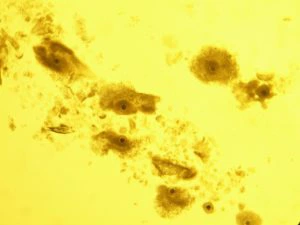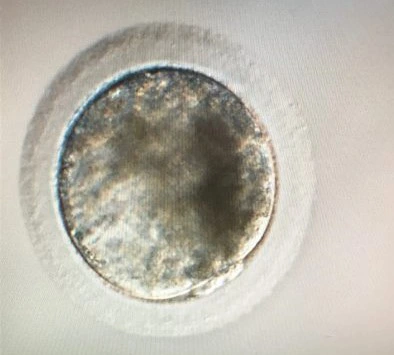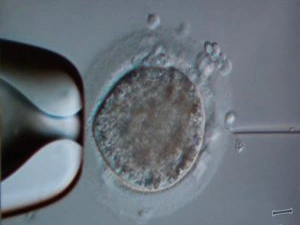Ovum Pick Up (OPU), also known as oocyte aspiration or oocyte collection is the procedure where oocytes (eggs) are collected by aspirating the follicular fluid. The OPU procedure is performed on the standing mare after sedation and administration of an epidural anaesthesia. OPU does not require hospital admission of the mare. Before scheduling an OPU appointment, the ovaries of the mare are assessed at home to determine if she is a suitable candidate. The ideal OPU candidate has a minimum of 15 follicles with a diameter less than 1cm. If there are not enough follicles present during this scan, the ovaries are reassessed 2-3 weeks later to allow enough time for follicular growth.
Unfortunately, oocytes by themselves are too small (125 -150mm) to visualise via ultrasound. The follicles, each containing a single oocyte are therefore visualised by inserting an ultrasound probe, equipped with a needle guide, into the vagina. The ovary is then grasped via the rectum and held against the vaginal wall. The fluid of each follicle 1cm is aspirated and subsequently flushed several times to enhance oocyte recovery. After aspiration of all the follicles, the recovered fluid is filtered in analogy with the recovered fluid after an embryo flush. This fluid is then searched for the presence of the oocytes (figure 1).

Figure 1 – Oocytes recovered via OPU
The oocytes are then transferred into a (special) transport medium and shipped to a specialised lab, without the loss of their fertility. Once the oocytes have arrived at the laboratory, they are placed in a maturation medium for 24h. This is because the recovered oocytes are not yet ready to be fertilised. They need to mature (ripe) further. During the normal cycle of the mare, this maturation happens while the follicle grows. This is why the veterinarian monitors the size of the follicles of your mare when she is in season. Once the oocyte is mature, the follicle will rupture and ovulation takes place. The oocyte is then caught by the oviduct and ready to be fertilised. Since we have removed the oocyte from the follicle, we need to mimic the conditions of the follicle in the lab. This is the goal of this maturation medium, which contains the same kind of hormones that are present in this follicular fluid. After the 24h of incubation in the maturation medium, the oocytes are assessed under the microscope to evaluate whether or not they have successfully matured. Only matured oocytes will be fertilised (figure 2).

Figure 2 – Mature Oocyte
Fertilisation in the lab is done by a technique called Intracytoplasmic Sperm Injection (ICSI) in which one spermatozoon is injected into the oocyte (figure 3). The oocyte is then transferred into another medium to promote the development into an embryo. This development takes between 7-9 days. The fertilised oocytes that have successfully developed into an embryo will then be frozen and stored into liquid nitrogen and is then shipped back to the clinic. The frozen embryo can be thawed at any moment during the breeding season when there is a suitable recipient mare available.

Figure 3 – The oocyte is held in place by a holding pipette (left) and the spermatozoon is in the injection pipette (right)
Why Choose OPU?
Sub-/infertility of the mare
- Unable to carry pregnancy
- Unable to produce embryo for embryo transfer
Stallion
- Reduced fertility
- Optimal use of limit stock of semen / expensive straw
- One 0.5ml straw of frozen semen can be used for 3-5 ICSI sessions (depending on quality)
- The same straw of semen can be used for several mares if the OPU is performed on the same day
Mares in competition
- no requirement hormonal treatment
- Single visit (OPU session takes about 2h)
Not seasonal
OPU is performed outside the breeding season
Frozen embryos
- Transferred during spring, summer → choose time when the foal will be born
- No recipient synchronisation stress
- Import and export frozen embryos
Last chance to produce offspring in case of sudden death of a mare
What to expect?
Chances to obtain one or more embryos per OPU-ICSI session are around 55%
Pregnancy results after transfer of an ICSI embryo are around 70 % and early embryonic losses of 10 – 15%. These results are variable between individuals, with some mares having multiple embryos every OPU session but unfortunately also mares that fail to produce embryos via OPU-ICSI.
What are the requirements
The mare should have at least 15 follicles larger than 1 cm.
The mare should undergo health test prior OPU (CEM, EIA, EVA)